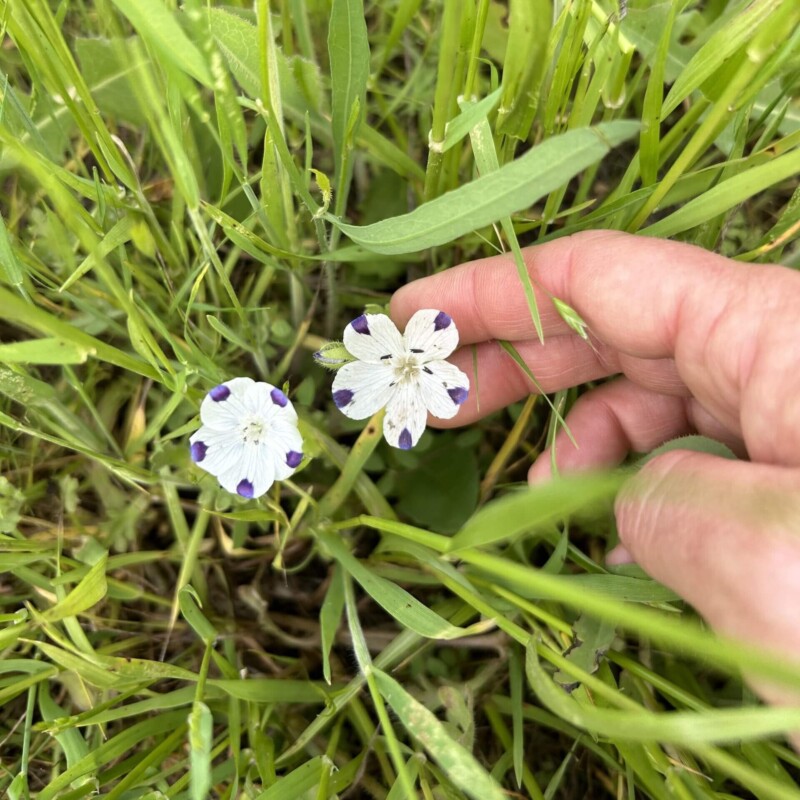On Sunday May 7, Sierra Nevada Alliance convened ten participants at the Magnolia Ranch Trailhead in Pilot Hill, California, for a wildflower walk with local botanist Molly Ferry. Attendees came from near and far to spend the day among the plants and learn about the unique ecosystems of the Sierra Foothills.
At the beginning of the hike, Molly gave a short talk on her professional history, sharing her enthusiasm for protecting our native plants. “We need more plant advocates,” she said, lamenting the general lack of advocacy and action that happens for plant diversity and protection. Molly then gave each attendee a sheet of paper with a chart listing about 80 different plant species. For each plant, the list included the family, common name, species name, Latin family name, and whether it was native or non-native.
 As we set off on our hike, Molly reminded us to ask questions any time and to point out flowers that we see along the way. Early on, one of our attendees spotted a beautiful cluster of small white flowers growing among the grasses next to the trail. Molly walked over, and her enthusiasm was contagious – it was a five-spot flower (Nemophila maculata), a beautiful native flower none of the attendees had ever seen before. Each small white petal had a dark purple spot on the outer edge, with delicate purple veins striped towards the middle.
As we set off on our hike, Molly reminded us to ask questions any time and to point out flowers that we see along the way. Early on, one of our attendees spotted a beautiful cluster of small white flowers growing among the grasses next to the trail. Molly walked over, and her enthusiasm was contagious – it was a five-spot flower (Nemophila maculata), a beautiful native flower none of the attendees had ever seen before. Each small white petal had a dark purple spot on the outer edge, with delicate purple veins striped towards the middle.
 As we continued on, the group rejoiced in spotting such a variety of flowers, asking questions about each one, and attempting to remember their names. Molly gave us tips and tricks to try to remember and highly encouraged us to learn family names, explaining how that can be a great place to start by paying attention to the similarities and differences of plants “from the inside out.”
As we continued on, the group rejoiced in spotting such a variety of flowers, asking questions about each one, and attempting to remember their names. Molly gave us tips and tricks to try to remember and highly encouraged us to learn family names, explaining how that can be a great place to start by paying attention to the similarities and differences of plants “from the inside out.”
Molly encouraged us to use a hand lens to look at the different parts of the flowers, and let us borrow hers if we didn’t have one. Paying attention to the small details can tell a lot about a plant species, such as the distinctive hooked pistil of a buttercup (Ranunculus californicus), indicating the “simplicity” of the plant, based on it having evolved so long before many of our more modern plants.
We had the luck of seeing a few species that are endemic to the Sierra Foothills, such as a species of evening primrose (Clarkia) that unfortunately wasn’t flowering quite yet, and California pipevine (Aristolochia californica), which was just past its flowering stage. Among our list of awesome flowering finds were gorgeous ground irises (Iris macrosiphon), fairy lantern lilies (Calochortus albus), a beautiful purple wild onion flower (Allium peninsulare), and lots of lupine (Lupinus bicolor). We also saw an abundance of oak trees, invasive scotch broom, and enjoyed the rushing American River while we stopped for lunch, listening to the birds calling around us and watching the pipestem swallowtail butterflies.

Molly’s plant knowledge and enthusiasm are infectious, creating the perfect atmosphere for learning about our native flora. We had the luxury of rescheduling from a rainy day to a gorgeous sunny day, and were so grateful for the opportunity to share the day with Molly and all of our enthusiastic attendees.


